Introduction: The Timeless Beauty of Multani Blue Pottery
Among the multifaceted, colorful, and vast world of handicrafts from India, few art forms are more visually stunning and historically rich than Multani Blue Pottery. Multani Blue Pottery has characterized traditional ceramic craft in this region, with its cobalt blue coloration and beautiful floral designs. This craftsmanship has grown into a cultural tradition in South Asia, especially in Punjab and Rajasthan in India, and Multan in present-day Pakistan.
This article will take you on a short journey through time to uncover the history, techniques, symbolism, and contemporary resurgence of Multani Blue Pottery, while also considering how this was a developing art form accommodating to modern tastes and markets. This guide will provide you with everything you will need to know about Multani Blue Pottery — discover this art form, whether you are a craft lover, collector or just curious about crafts from around the world.
Table of Contents
Origins: Tracing the Roots of Multani Blue Pottery
The tale of Multani Blue Pottery starts not in India, but rather in Central Asia, where Persian and Mughal artisans brought the traditions of their native ceramics to the subcontinent during the medieval ages. The name “Multani” refers to the city of Multan, which is now part of present-day southern Pakistan, and was historically a center of exchange and culture in the Silk Road.
Multani Blue Pottery is fundamentally different from traditional pottery, which is made from clay. While traditional pottery uses clay to make vessels, Multani Blue Pottery is made with a glass ceramic or, more accurately described, a glassy mixture made from quartz, powdered glass, and/or natural materials. The Turko-Persian invaders brought this blue-glazed technique to the Indian sub-continent, and it was brought to its peak by the Mughal Emperors, who, as connoisseurs of fine arts and architecture, were supportive of artisans who produced high-quality ceramics.
During British colonial times, the craft consequently fell out of favor, due in large part to the decline of royal patronage and the rise of mass manufacturing by industrial means. However, after decades of neglect, thanks in part to the cultural preservation efforts, regional artisans from the west and former royal family members, especially from Jaipur, Delhi, and Jodhpur communities, blue pottery underwent a renaissance at the beginning of the last decade.
What Makes Multani Blue Pottery Unique?
Colour Palette: The Signature Cobalt Blue
The quintessential nature of Multani Blue Pottery is that it is in unmistakable cobalt blue colour against a white or off-white backdrop. This contrast gives the eye something to graze and provides both a calming and breathtaking visual effect. Blue is the dominant colour in the pottery, but there may be hints of green, yellow, or even purple in some of the pieces without losing the emphasis of blue.
Material and Compositions: The main difference with Multani Blue Pottery compared to traditional clay pottery is that there is a non-clay base. The main components are:
– Quartz powder
– Glass powder
– Whiting (calcium carbonate)
– Multani mitti (Fuller’s earth)
These items are then mixed with water in their powdered state, added natural binders are added to get a malleable paste. Multani Blue Pottery remains ornamental, and a glass-like finish after the firing process, making it more fragile and fragile than traditional pottery.
Techniques and Procedure: Making a piece of Multani Blue Pottery requires patience, precision, and skill. Here is an overview of the process:
Preparation of the dough: The raw material is taken and ground to a powder to a fine powder. The raw material is mixed with gum arabic or other natural carbohydrates, so it resembles a dough-like state.
Shaping: Unlike thrown pottery, Multani pottery entails sculpting with plaster molds into shapes such as plates, tiles, vases, and decorative panels.
Drying: The items are then left to dry in a controlled manner to prevent cracking.
Hand Painting: The pieces are then hand-painted by skilled artists, using a brush made from either squirrel hair or fine bamboo and bringing in floral, arabesque, and geometric designs.
First Firing (Biscuit Firing): After the painted pieces have dried, they go through a first firing at low temperatures to harden the objects.
Glazing: Cobalt oxide is added to a clear glaze and applied to create the blue sheen seen in different items.
Second Firing (Gloss Firing): The glazed items are then fired a second time at higher kiln temperatures to create a glossy, glassy surface identifier for Multani pottery.
The two-firing allows for the durability of the item while maintaining the fragility of the beauty of the object.
Design Motifs and Symbolism
Floral Patterns: A Reflection on Nature
It is impossible to discuss the topic of Multani Blue Pottery without mentioning the beautiful floral patterns that are synonymous with Multani Blue Pottery. Some common motifs include:
Paisley (Mango) motifs, Lotus flowers,Peony flowers, Vines, and leaves.
These motifs are not mere ornamental patterns; they all have symbolic significance that is derived from Islamic and Mughal traditions. Flowers represent heaven and divine beauty, while vines represent a sense of eternal life and interconnectedness.
Geometric and Calligraphic Elements
In addition to the floral motifs, Multani Blue Pottery may also include geometric patterns, such as stars, polygons, and tessellations. These patterns reflect the mathematical precision held in high regard in Islamic art.A dditionally, many inscriptions are used and typically written in either Persian or Urdu, quoting poetry or other spiritual verse, which adds a literary element to the visual aesthetic.
Cultural Significance and Regional Influence
A Legacy of Craftsmanship
Multani Blue Pottery is not only a craft but a living tradition that is a reflection of the history, aesthetic, and ideas of the communities that have practiced the craft. The craft required the master-craftsman to convey their knowledge to the pupil, and often share a familial connection, creating a legacy of craft, knowledge, and creativity.
During the Mughal period, blue pottery embellished palaces, mosques, and tombs. Today, blue pottery still embellishes homes, museums, and galleries worldwide that echo combinations of past and present.
Regional Variants Across South Asia
Although Multani Blue pottery is only found in Multan, there are related styles of pottery in South Asia, such as: Jaipur Blue Pottery (India): Jaipur pottery is known for its turquoise shades with white backdrops. Jaipur is similar to Multani work; however, Jaipur pottery has different elements in terms of material combinations and design considerations.
Afghanistani and Iranian Tilework: Multani influenced artisans from Afghanistan and Iran through their monumental architectural usages of blue glazing.
Despite the regional variances of these three styles of pottery and regional influences, they all originated from the same aesthetic philosophy, culturally, to celebrate symmetry, nature, and spirituality in color and form.
Challenges and Revival
Threats to a Dying Art
Many traditional crafts are going through struggles, and Multani Blue Pottery has several problems currently occurring.
– Shrinking number of skilled artisans,
– Absence of formal training institutions,
– Presenting competition from mass-produced, copied imitations,
– Economic hardship is causing children of artisans to leave the profession.
– Lastly, there is no denying the fact that the labor intensity of the process and the high costs complicate the efforts of artisans trying to compete in a fast-paced world.
Preservation and Revitalization Movement
Fortunately, there is renewed interest in artistic preservation, and new programs or models for support have emerge,d including:
* Artisan support through government grants and programs
* Workshops and exhibits conducted through an NGO
* Collaborations with pinch and modern designers
* Tourism promotion of Multan
Organizations, such as the National Council of the Arts (Pakistan) and internationally, such as UNESCO, have recognized the importance of the Multani Blue Pottery tradition and have encouraged the documentation, training, and promotion of it around the world.
Artisans are also experimenting with new forms to find the balance of being appealing to contemporary audiences while still drawing on tradition; things like new tableware, lamps, jewelry boxes, and wall art.
How to Identify Authentic Multani Blue Pottery
As blue pottery becomes more popular, the amount of counterfeits will increase as well. Here are some sure-fire ways to distinguish real Multani Blue Pottery from knockoffs:
Material Feel: Real pieces feel somewhat cold and smooth, along the lines of porcelain.
Weight: Because it has a non-clay base it, real Multani pottery will be lighter than most ceramics.
Painting Style: Look for all hand-painted pieces, as they would never come with the machine-like, repetitive paint applications.
Signature Marks: Some artisans leave their signature on their goods, and may also stamp it with their workshop logo.
Craftsmanship Quality: Real pieces will have no cracks, bubbles, or imperfect glaze.
Lastly, when you purchase it, you should always purchase it from an established, reputable source or from the artisan. This will help ensure that you are buying a genuine article while also supporting the community.
Where to Experience Multani Blue Pottery Today
Multan: The Living Centre of Craft
To experience Multani Blue Pottery, there is no substitute for a visit to Multan. Must-see venues include: Sufiyan Waza Crafts Center, Multan Arts Council, Heritage Markets space near the Ghanta Ghar (Clock Tower) , Local workshops located in Bohar Gate and Husainagah. Here, you can watch artisans at work, buy handmade gifts, and learn how the craft has developed through its historical context. Beyond Pakistan: An Internationally Recognized Craft
Through exhibiting and cultural exchange in Multan, Multani Blue Pottery has found itself in international demand. You may find Museums in India, the UK, and the USA, International fairs (handicrafts) and , Online sites emphasizing ethical and sustainable crafts
Its timeless accomplishments continue to inspire interior designers, collectors, and art lovers across the globe.
Conclusion: Preserving a Masterpiece of Heritage
Multani Blue Pottery is a powerful reminder of how art can cross oceans, cultures, and hundreds of years in time. Multani Blue Pottery is always unmistakable with its cobalt blue hues and detailed designs of empires, saints, and daily lives intermixed as multifaceted seasons of colours and form.
The more we go deeper into the digital world, the more we have to work to protect and celebrate arts such as artisanal craft. By supporting artisans, listening to their stories, and appreciating their arts, you are ensuring that this wonderful art form continues and is appreciated by future generations.
The next time you see a piece of blue pottery, it is important for you to understand that you are not just holding a decorative object—you are holding a trace of history, a whisper of the past, and an essence of humanity’s inspiration.
Q1: Is Multani Blue Pottery the same as Jaipur Blue Pottery?
A: While both share similar aesthetics, they differ in materials, techniques, and regional influences. Multani pottery uses quartz and glass powder, whereas Jaipur pottery often includes frit glass.
Q2: Can Multani Blue Pottery be used for functional purposes?
A: Due to its delicate nature, it’s mostly used for decorative purposes. However, some items like plates and bowls are food-safe and suitable for light use.
Q3: Where can I buy authentic Multani Blue Pottery?
A: Visit Multan’s local markets, authorized craft centers, or trusted online retailers specializing in traditional Pakistani handicrafts.

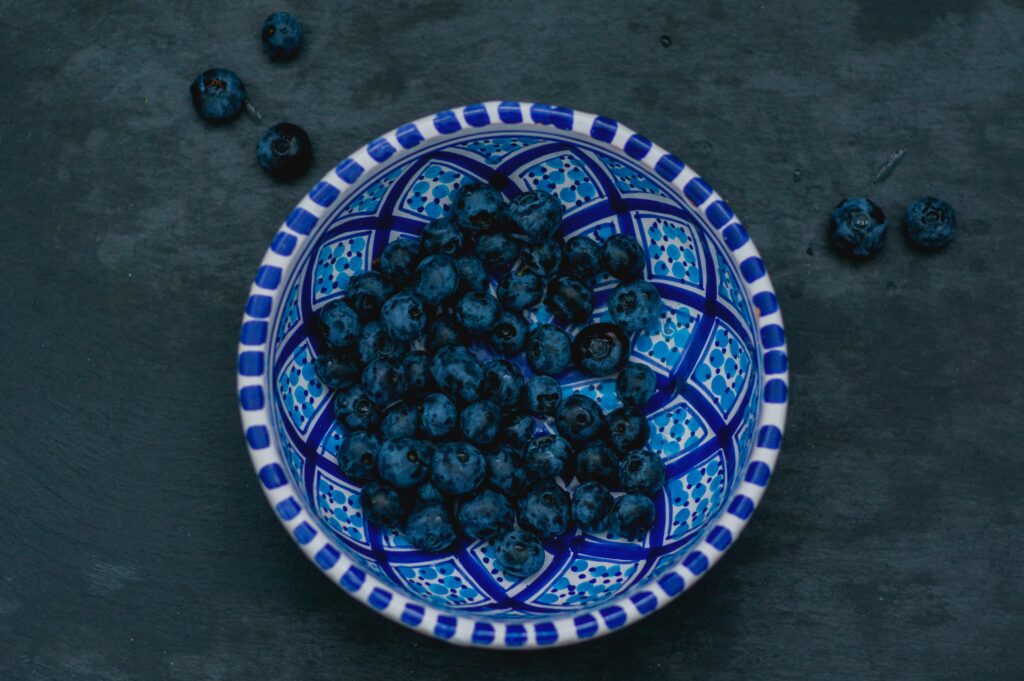
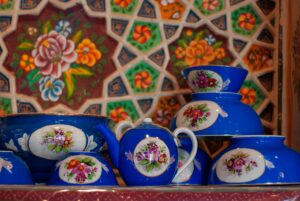
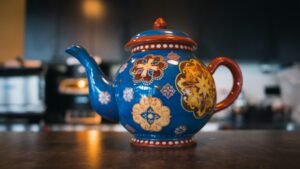
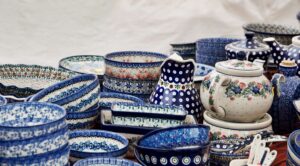
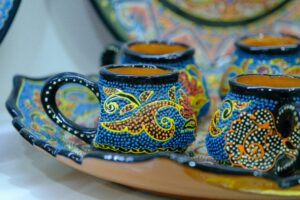
One thought on “Multani Blue Pottery: 10 Amazing Insights into the Soul of a Timeless Handcrafted Legacy”